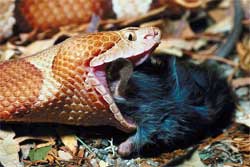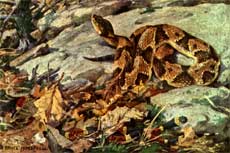|

They look like everyone else: Adult specimens have a coppery colored head and neck. They are not
large snakes, generally about 50 cm long (1.5 ft), but specimens
up to 1 m long (3 ft) have been encountered. The body is thin by
pit viper standards. There are five clearly defined subspecies.
All subspecies have distinctive light and dark brown or reddish banding.
A. c. mokasen, A. c. contortrix and A. c. phaeogaster have bands
that tend to narrow dorsally, giving them an hourglass shape, whereas
A. c. laticinctus and A. c. pictigaster generally have bands of
uniform width. Intergrading occurs in areas where the subspecies
geographic ranges overlap, so pattern variations are commonplace.
A. c. pictigaster is known especially for its distinctively patterned
underside, with white and black banding.


Sneak Attack!: Like all pit vipers, the copperhead is an ambush predator: it takes
up a promising position and waits for suitable prey to arrive. Roughly
90% of its diet consists of small rodents, such as mice and voles.
 Mama Mia: The copperhead breeds in late summer, but not every year: sometimes
a female will produce young for several years running, then not
breed at all for a time. They give birth to live young about 20
cm long: a typical litter is 4 to 7, but it can be as few as one
or as many as 20. Their size apart, the young are similar to the
adults, but lighter in color, and with a yellow-marked tip to the
tail, which is used to lure lizards and frogs. Mama Mia: The copperhead breeds in late summer, but not every year: sometimes
a female will produce young for several years running, then not
breed at all for a time. They give birth to live young about 20
cm long: a typical litter is 4 to 7, but it can be as few as one
or as many as 20. Their size apart, the young are similar to the
adults, but lighter in color, and with a yellow-marked tip to the
tail, which is used to lure lizards and frogs.
Stay Out of the Pool: Commonly, the average person will assume any reddish or brownish
snake is a copperhead. This is far from the case. Many harmless
snakes, such as the brown snake (genus Storeria), or water snake
(genus Nerodia) are frequently mistaken for copperheads. Copperheads
are primarily a terrestrial species, and though quite capable swimmers,
they are rarely found swimming.
 Windows to the soul: The easiest way to tell venomous snakes from non-venomous in North
America is by the shape of their pupils. All venomous snakes in
North America, with the exception of the coral snake, are pit vipers
and have a vertical type pupil, Windows to the soul: The easiest way to tell venomous snakes from non-venomous in North
America is by the shape of their pupils. All venomous snakes in
North America, with the exception of the coral snake, are pit vipers
and have a vertical type pupil,
like a cat's eye. All non-venomous
snakes in North America have a round pupil like a human.
Once Bitten, Twice Shy: The best way to avoid being bitten when in the outdoors in copperhead
country is to be aware of their typical behavior and habitats and
take appropriate precautions. Like most North American vipers, copperheads
prefer to avoid humans and, given the opportunity, will leave the
area without biting; however, unlike the rattlesnake, they are unable
to make an audible warning of their presence.
Scared Stiff: Copperheads often tend to "freeze" instead of slithering
away; thus, many bites come from people unknowingly stepping on
or near them. This tendency to freeze likely evolved because of
the extreme effectiveness of their camouflage. When laying on dead
leaves or red clay they can be almost impossible to notice. They
will frequently stay still even when approached closely, and will
only generally strike if physically harassed or trod upon.
 Look Carefully: Small hiding places such as niches in rock walls, woodpiles, etc.,
should be examined before hands or feet are placed in them, and
one should stand on or bend over a fallen log to look for a snake
instead of blindly jumping over. Favorite habitats include rocky
hillsides above wooded streams. In the south, copperheads are nocturnal
during the hot summer months, but are commonly active during the
day during the spring and fall. A pair of stout leather hiking boots
might blunt the strike of a snake. Heavy tramping of feet will cause
vibrations in the ground that can alert snakes to peoples' presence,
giving them time to quietly escape. The majority of snakebite incidents
are the result of attempting to handle the snake or attacking it
with an object. Look Carefully: Small hiding places such as niches in rock walls, woodpiles, etc.,
should be examined before hands or feet are placed in them, and
one should stand on or bend over a fallen log to look for a snake
instead of blindly jumping over. Favorite habitats include rocky
hillsides above wooded streams. In the south, copperheads are nocturnal
during the hot summer months, but are commonly active during the
day during the spring and fall. A pair of stout leather hiking boots
might blunt the strike of a snake. Heavy tramping of feet will cause
vibrations in the ground that can alert snakes to peoples' presence,
giving them time to quietly escape. The majority of snakebite incidents
are the result of attempting to handle the snake or attacking it
with an object.
911!: If bitten, one should not apply a tourniquet or suck blood from
the bite — the victim should be kept calm and be transported
to a hospital as quickly as possible. A tourniquet will increase
tissue damage in the area of the bite and may even create the need
to amputate a bitten limb that may have otherwise been saved. Never
cut where the bite is.
All text is available under the terms
of the GNU Free Documentation License
|